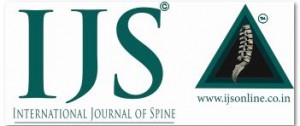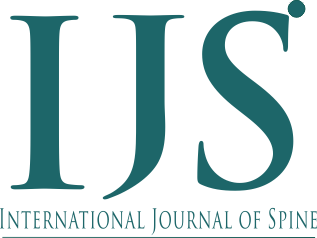Ewing’s Sarcoma of Spine-Current Concepts and Review of literature
Volume 7 | Issue 2 | July-December 2022 | Page: 14-18 | Rajendra Sakhrekar, Samuel Yoon, Carlo Iorio, Saijyot Raut
DOI: https://doi.org/10.13107/ijs.2022.v07i02.39
Authors: Rajendra Sakhrekar [1, 2], Samuel Yoon [1. 2], Carlo Iorio [1, 2, 3], Saijyot Raut [4, 5], Aditya Raj [6]
[1] Division of Orthopaedic Surgery, The Hospital for Sick Children, 555 University Avenue Toronto, Canada M5G1X8.
[2] Division of Orthopaedic Surgery, University of Toronto, Canada.
[3] Spine Surgery Unit, Department of Surgery, Bambino Gesù Children’s Hospital, Rome, Italy.
[4] One Spine Clinic, Mumbai, Maharashtra, India.
[5] Department of Spine Surgery, SL Raheja Hospital, Mumbai, Maharashtra, India.
[6] Division of Orthopaedic Surgery, Toronto Western Hospital, Canada.
Address of Correspondence
Dr. Rajendra Sakhrekar
Division of Orthopaedic Surgery, The Hospital for Sick Children, 555 University Avenue, Toronto, ON, Canada M5G 1X8 & Division of Orthopaedic Surgery, University of Toronto, Canada.
E-mail: raj.sakhrekar@gmail.com
Abstract
Introduction- Ewing sarcoma (ES) is a malignant and aggressive bony tumor affecting the most common age group of 5-20 years. It constitutes 10%-15% of all bone sarcomas and is the second most common primary malignant bone tumor after osteosarcoma.
Methods- We undertook a review of the literature on Ewing’s Sarcoma of the spine to evaluate its etiology, clinical presentations, differential diagnosis, imaging modalities, and management with chemotherapy, radiotherapy, and surgical management. PubMed, EMBASE, Google Scholar, and Cochrane key articles were searched. Keywords like ‘Ewing’s Sarcoma’, ‘Spine’, ‘etiology’, ‘treatment’, ‘surgical management’, and ‘en bloc resection’ were used
Discussion- The current management of Ewing’s sarcoma of the spine usually involves three main modalities: combination chemotherapy, surgery, and/or radiotherapy. Recent improvements in combination chemotherapy (vincristine, doxorubicin, cyclophosphamide +/- Ifosfamide, and etoposide) are one of the most significant factors for improving survival. Also, recent advancements in radiotherapy and instrumentation, and fusion techniques in surgical management have also been demonstrated to improve local disease control and overall survival.
Conclusion- Primary Ewing sarcoma of the spine is a rare condition affecting the most common age group of 5-20 years and accounting for 1-3 cases/million/year. About 5 % of cases have spine involvement. Recent improvements in combination chemotherapy have improved the overall survival rates. En block resection and/or radiotherapy have improved local control of the disease.
Keywords: Ewing’s Sarcoma, Spine, etiology, Treatment, Surgical management, En-bloc resection
References
1. Ewing J (2006) THE CLASSIC: Diffuse Endothelioma of Bone. Clin Orthop Relat Res 450:25–27.
2. Ludwig JA (2008) Ewing sarcoma: historical perspectives, current state-of-the-art, and opportunities for targeted therapy in the future. Curr Opin Oncol 20:412–418.
3. Esiashvili N, Goodman M, Marcus RB (2008) Changes in Incidence and Survival of Ewing Sarcoma Patients Over the Past 3 Decades. J Pediatr Hematol Oncol 30:425–430.
4. Sciubba DM, Okuno SH, Dekutoski MB, Gokaslan ZL (2009) Ewing and Osteogenic Sarcoma. Spine (Phila Pa 1976) 34:S58–S68.
5. Lessnick SL, Ladanyi M (2012) Molecular Pathogenesis of Ewing Sarcoma: New Therapeutic and Transcriptional Targets. Annual Review of Pathology: Mechanisms of Disease 7:145–159.
6. WIDHE B, WIDHE T (2000) Initial Symptoms and Clinical Features in Osteosarcoma and Ewing Sarcoma*. The Journal of Bone and Joint Surgery-American Volume 82:667–674.
7. Biermann JS, Chow W, Reed DR, Lucas D, Adkins DR, Agulnik M, Benjamin RS, Brigman B, Budd GT, Curry WT, Didwania A, Fabbri N, Hornicek FJ, Kuechle JB, Lindskog D, Mayerson J, McGarry S V., Million L, Morris CD, Movva S, O’Donnell RJ, Randall RL, Rose P, Santana VM, Satcher RL, Schwartz H, Siegel HJ, Thornton K, Villalobos V, Bergman MA, Scavone JL (2017) NCCN Guidelines Insights: Bone Cancer, Version 2.2017. Journal of the National Comprehensive Cancer Network 15:155–167.
8. MartÍnez MA, GarcÍ RN, GalvÁn JJC, Marrero OBá, Castro IG (2003) Ewing’s Sarcoma: Histopathological and Immunohistochemical Study. Orthopedics 26:723–725.
9. Nogueira Drumond JM (2010) EFFICACY OF THE ENNEKING STAGING SYSTEM IN RELATION TO TREATING BENIGN BONE TUMORS AND TUMOR-LIKE BONE LESIONS. Revista Brasileira de Ortopedia (English Edition) 45:46–52.
10. Enneking WF. (1986) A system of staging musculoskeletal neoplasms. Clin Orthop Relat Res 9–24.
11. Amin MB, Greene FL, Edge SB, Compton CC, Gershenwald JE, Brookland RK, Meyer L, Gress DM, Byrd DR, Winchester DP (2017) The Eighth Edition AJCC Cancer Staging Manual: Continuing to build a bridge from a population-based to a more “personalized” approach to cancer staging. CA Cancer J Clin 67:93–99.
12. Chan P, Boriani S, Fourney DR, Biagini R, Dekutoski MB, Fehlings MG, Ryken TC, Gokaslan ZL, Vrionis FD, Harrop JS, Schmidt MH, Vialle LR, Gerszten PC, Rhines LD, Ondra SL, Pratt SR, Fisher CG (2009) An Assessment of the Reliability of the Enneking and Weinstein-Boriani-Biagini Classifications for Staging of Primary Spinal Tumors by the Spine Oncology Study Group. Spine (Phila Pa 1976) 34:384–391.
13. Kandel R, Coakley N, Werier J, Engel J, Ghert M, Verma S (2013) Surgical Margins and Handling of Soft-Tissue Sarcoma in Extremities: A Clinical Practice Guideline. Current Oncology 20:247–254.
14. Durer S SH (2023) Ewing Sarcoma. StatPearls Publishing.
15. Paulussen M, Craft AW, Lewis I, Hackshaw A, Douglas C, Dunst J, Schuck A, Winkelmann W, Köhler G, Poremba C, Zoubek A, Ladenstein R, van den Berg H, Hunold A, Cassoni A, Spooner D, Grimer R, Whelan J, McTiernan A, Jürgens H (2008) Results of the EICESS-92 Study: Two Randomized Trials of Ewing’s Sarcoma Treatment—Cyclophosphamide Compared With Ifosfamide in Standard-Risk Patients and Assessment of Benefit of Etoposide Added to Standard Treatment in High-Risk Patients. Journal of Clinical Oncology 26:4385–4393.
16. Schuck A, Ahrens S, Paulussen M, Kuhlen M, Könemann S, Rübe C, Winkelmann W, Kotz R, Dunst J, Willich N, Jürgens H (2003) Local therapy in localized Ewing tumors: results of 1058 patients treated in the CESS 81, CESS 86, and EICESS 92 trials. International Journal of Radiation Oncology*Biology*Physics 55:168–177.
17. Bacci G, Longhi A, Briccoli A, Bertoni F, Versari M, Picci P (2006) The role of surgical margins in treatment of Ewing’s sarcoma family tumors: Experience of a single institution with 512 patients treated with adjuvant and neoadjuvant chemotherapy. International Journal of Radiation Oncology*Biology*Physics 65:766–772.
18. Womer RB, West DC, Krailo MD, Dickman PS, Pawel BR, Grier HE, Marcus K, Sailer S, Healey JH, Dormans JP, Weiss AR (2012) Randomized Controlled Trial of Interval-Compressed Chemotherapy for the Treatment of Localized Ewing Sarcoma: A Report From the Children’s Oncology Group. Journal of Clinical Oncology 30:4148–4154.
19. Schuck A, Ahrens S, Paulussen M, Kuhlen M, Könemann S, Rübe C, Winkelmann W, Kotz R, Dunst J, Willich N, Jürgens H (2003) Local therapy in localized Ewing tumors: results of 1058 patients treated in the CESS 81, CESS 86, and EICESS 92 trials. International Journal of Radiation Oncology*Biology*Physics 55:168–177.
20. Sciubba DM, Okuno SH, Dekutoski MB, Gokaslan ZL (2009) Ewing and Osteogenic Sarcoma. Spine (Phila Pa 1976) 34:S58–S68.
21. Nogueras JJ, Jagelman DG (1993) Principles of Surgical Resection: Influence of Surgical Technique on Treatment Outcome. Surgical Clinics of North America 73:103–116.
22. Lu M, Zhou Z, Chen W, Lei Z, Dai S, Hou C, Du S, Jin Q, Jin D, Boriani S, Li H (2022) En bloc resection of huge primary tumors with epidural involvement in the mobile spine using the “rotation–reversion” technique: Feasibility, safety, and clinical outcome of 11 cases. Front Oncol 12:.
23. Tomita K, Kawahara N, Murakami H, Demura S (2006) Total en bloc spondylectomy for spinal tumors: improvement of the technique and its associated basic background. Journal of Orthopaedic Science 11:3–12.
24. Harrop JS, Schmidt MH, Boriani S, Shaffrey CI (2009) Aggressive “Benign” Primary Spine Neoplasms. Spine (Phila Pa 1976) 34:S39–S47.
25. Sharafuddin MJ HFHPHS el-KGY (1992) Treatment options in primary Ewing’s sarcoma of the spine: report of seven cases and review of the literature. Neurosurgery 610–618.
26. Talac R, Yaszemski MJ, Currier BL, Fuchs B, Dekutoski MB, Kim CW, Sim FH (2002) Relationship Between Surgical Margins and Local Recurrence in Sarcomas of the Spine. Clin Orthop Relat Res 397:127–132.
27. Boriani S ALCACMBSFS (2011) Ewing’s sarcoma of the mobile spine. Eur Rev Med Pharmacol Sci 15:831–839.
28. Hesla AC, Bruland ØS, Jebsen N, Styring E, Eriksson S, Tsagozis P (2019) Ewing sarcoma of the mobile spine; predictive factors for survival, neurological function and local control. A Scandinavian sarcoma group study with a mean follow-up of 12 years. J Bone Oncol 14:100216.
| How to Cite this Article: Sakhrekar R, Yoon S, Iorio C, Raut S, Raj A | Ewing’s Sarcoma of Spine-Current Concepts and Review of literature | International Journal of Spine | July- December 2022; 7(2): 14-18 | https://doi.org/10.13107/ijs.2022.v07i02.39 |


